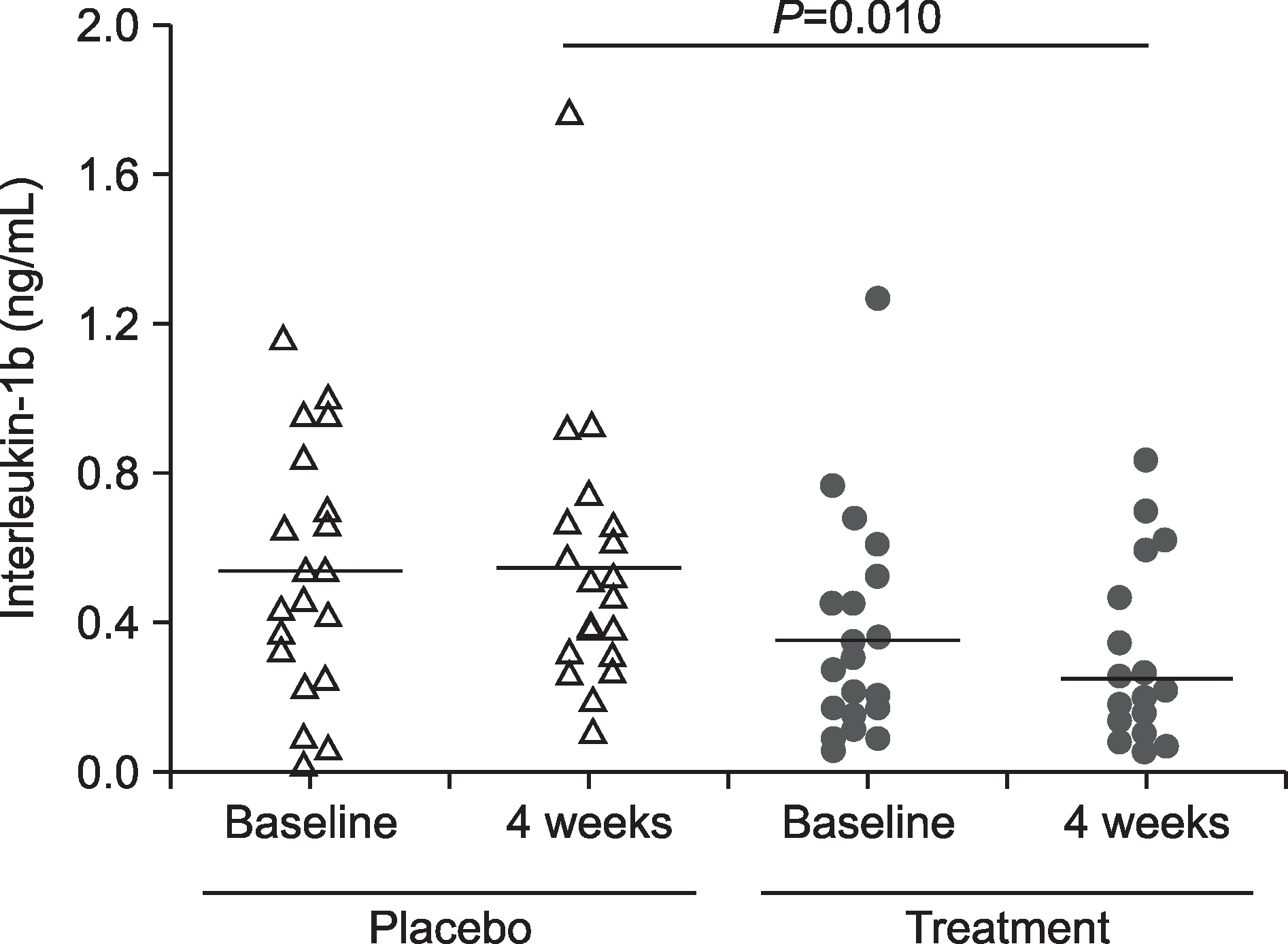J Korean Acad Oral Health.
2013 Dec;37(4):175-179.
Polycan-calcium gluconate complex improves gingival health
- Affiliations
-
- 1Department of Preventive Dentistry, Kyungpook National University School of Dentistry, Daegu, Korea. kbsong@knu.ac.kr
- 2Department of Oral Biochemistry, Kyungpook National University School of Dentistry, Daegu, Korea.
Abstract
OBJECTIVES
The aim of this study was to examine the effect of a Polycan-calcium gluconate complex on gingival health.
METHODS
Forty-one subjects with mild periodontitis (> or =40 years) were divided into two groups: the placebo and test product (Polycan-calcium gluconate complex twice a day for 4 weeks) groups. Oral examination was performed and gingival crevicular fluid (GCF) was collected from each subject at baseline and after 4 weeks. Interleukin (IL)-1beta level in the GCF was determined using enzyme-linked immunosorbent assay.
RESULTS
Pocket depth and plaque index were significantly decreased in the test group at 4 weeks. The level of IL-1beta and plaque index of the treatment group was significantly lower than of the placebo group.
CONCLUSIONS
Based on the above results, Polycan-calcium gluconate complex may inhibit plaque accumulation in the mouth and may have a negative correlation with the level of inflammatory biomarkers. Consequently, gingival health was significantly improved by polycan-calcium gluconate complex.
Keyword
MeSH Terms
Figure
Reference
-
References
1. Pihlstrom BL, Michalowicz BS, Johnson NW. Periodontal diseases. Lancet. 2005; 366:1809–1820.
Article2. Ministry of Health and Welfare. 2011 National Health Insurance Statistical Yearbook. Seoul: Ministry of Health & Welfare;2011. p. 555–617.3. Lee SY, Jung YH, Kim KH, Yang BK, Han SB, Chung CP, et al. Matrix metalloproteinases and tissue inhibitors of matrix metalloproteinases in gingival crevicular fluids of periodontitis patients. J Korean Acad periodontol. 2004; 34:139–148.
Article4. Dongari-Bagtzoglou AI, Ebersole JL. Production of inflammatory mediators and cytokines by human gingival fibroblasts following bacterial challenge. J Periodontal Res. 1996; 31:90–98.
Article5. Birkedal-Hansen H. Role of cytokine and inflammatory mediators in tissue destruction. J Periodontal Res. 1993; 28:500–510.6. Hernández Ríos M, Sorsa T, Obregón F, Tervahartiala T, Valenzuela MA, Pozo P, et al. Proteolytic roles of matrix metalloproteinase (MMP)-13 during progression of chronic periodontitis: initial evidence for MMP-13/MMP-9 activation cascade. J Clin Periodontol. 2009; 36:1011–1017.
Article7. Bonesvoll P. Oral pharmacology of chlorhexidine. J Clin Periodon-tol. 1977; 4:49–65.
Article8. Khoo JG, Newman HN. Subgingival plaque control by a simplified oral hygiene regime plus local chlorhexidine or metronidazole. J Periodontal Res. 1983; 18:607–619.
Article9. Chan GCF, Chan WK, Sze DMY. The effects of β-glucan on human immune and cancer cells. J Hematol Oncol. 2009; 2:1–11.
Article10. Song HS, Moon KY. In vitro antioxidant activity profiles of β-glucan isolated from yeast Saccharomayces cerevisiae and mutant Saccharomayces cerevisiae IS2. Food Sci Biotechnol. 2006; 15:437–440.11. Kogan G, Pajtinka M, Babioncova M, Miadokova E, Rauko P, Sla-menova D, et al. Yeast cell wall polysaccharides as antioxidants and antimutagens: can they fight cancer? Neoplasma. 2008; 55:387–393.12. Novak M, Vetvicka V. Beta-glucans, history, and the present: immunomodulatory aspects and mechanisms of action. J Immuno-toxicol. 2008; 5:47–57.13. Abdel-Salam OM, Baiuomy AR, El-batran S, Arbid MS. Evaluation of the anti-inflammatory, anti-nociceptive and gastric effects of Ginkgo biloba in the rat. Pharmacol Res. 2004; 49:133–142.
Article14. Shin HD, Yang KJ, Park BR, Son CW, Jang HJ, Ku SK. Antios-teoporotic effect of polycan, beta-glucan from Aureobasidium, in ovariectomized osteoporotic mice. Nutrition. 2007; 23:853–860.15. Song HB, Park DC, Do GM, Hwang SL, Lee WK, Kang HS, et al. Effect of exopolymers of Aureobasidium pullulans on improving osteoporosis induced in ovariectomized mice. J Microbiol Biotechnol. 2006; 16:37–45.16. Queiroz LS, Nascimento MS, Cruz AK, Castro AJ, Moura Mde F, Baseia IG, et al. Glucans from the Caripia montagnei mushroom present anti-inflammatory activity. Int Immunopharmacol. 2010; 10:34–42.
Article17. Kim YS, Kang SJ, Kim JW, Cho HR, Moon SB, Kim KY, et al. Effects of Polycan, a β-glucan, on experimental periodontitis and alveolar bone loss in Sprague-Dawley rats. J Periodontal Res. 2012; 47:800–810.
Article18. Bracken WM, Cuppage F, McLaury RL, Kirwin C, Klaassen CD. Comparative effectiveness of topical treatments for hydrofluoric acid burns. J Occup Med. 1985; 27:733–739.19. Cavallini M, de Boccard F, Corsi MM, Fassati LR, Baruffaldi Preis FW. Serum pro-inflammatory cytokines and chemical acid burns in rats. Ann Burns Fire Disasters. 2004; 17:84–87.20. Karnad AS, Patil PA, Majagi SI. Calcium enhances anti-inflammatory activity of aspirin in albino rats. Indian J Pharmacol. 2006; 38:397–402.
Article21. Ku SK, Cho HR, Sung YS, Kang SJ, Lee YJ. Effects of calcium gluconate on experimental periodontitis and alveolar bone loss in rats. Basic Clin Pharmacol Toxicol. 2011; 108:241–250.
Article22. Silness J, Löe H. Periodontal disease in pregnancy.II. Correlation between oral hygiene and periodontal condition. Acta Odontol Scand. 1964; 22:121–135.23. Ainslie PT, Caffesse RG. A biometric evaluation of gingival curettage (II). Quintessence Int Dent Dig. 1981; 12:609–614.24. Cercek JF, Kiger RD, Garrett S, Egelberg J. Relative effects of plaque control and instrumentation on the clinical parameters of human periodontal disease. J Clin Periodontol. 1983; 10:46–56.
Article25. Figueredo CM, Ribeiro MS, Fischer RG, Gustafsson A. Increased interleukin-1β concentration in gingival crevicular fluid as a characteristic of periodontitis. J Periodontol. 1999; 70:1457–1463.
Article26. Gamonal J, Acevedo A, Bascones A, Jorge O, Silva A. Level of interleukin-1β, -8, and -10 and RANTES in gingival crevicular fluid and cell populations in adult periodontitis patients and the effect of periodontal treatment. J Periodontol. 2000; 71:1535–1545.27. Rawlinson A, Dalati MH, Rahman S, Walsh TF, Fairclough AL. Interleukin-1 and IL-1 receptor antagonist in gingival crevicular fluid. J Clin Periodontol. 2000; 27:738–743.
Article
- Full Text Links
- Actions
-
Cited
- CITED
-
- Close
- Share
- Similar articles
-
- A Case of Cutaneous Calcium Deposition Following Extravasation of Infused Calcium Gluconate
- Two Cases of Iatrogenic Calcinosis Cutis Following Extravasation of Calcium Gluconate in Neonates
- Extravasation of Calcium Gluconate Leading to the Soft Tissue Mass in the Dorsum of the Wrist and Hand in a Neonate
- A Case of Calcinosis Cutis due to Intravenous Administration of Calcium Gluconate
- Hydrofluoric Acid Burn on a Fingertip Treated Successfully with Single Session of Subcutaneous Injection of 6.7% Calcium Gluconate


